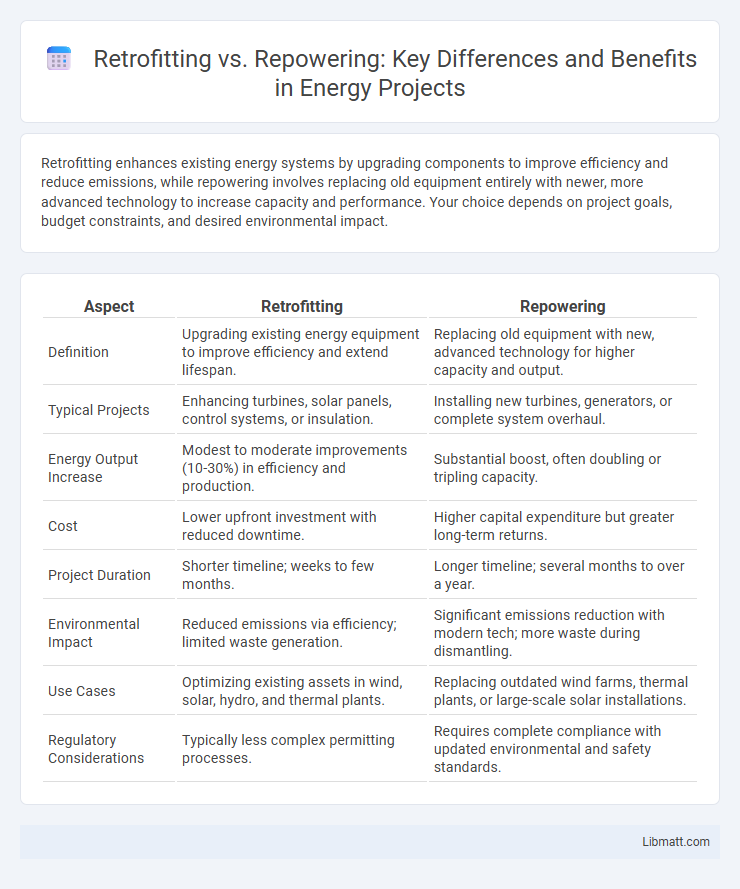Retrofitting enhances existing energy systems by upgrading components to improve efficiency and reduce emissions, while repowering involves replacing old equipment entirely with newer, more advanced technology to increase capacity and performance. Your choice depends on project goals, budget constraints, and desired environmental impact.
Table of Comparison
| Aspect | Retrofitting | Repowering |
|---|---|---|
| Definition | Upgrading existing energy equipment to improve efficiency and extend lifespan. | Replacing old equipment with new, advanced technology for higher capacity and output. |
| Typical Projects | Enhancing turbines, solar panels, control systems, or insulation. | Installing new turbines, generators, or complete system overhaul. |
| Energy Output Increase | Modest to moderate improvements (10-30%) in efficiency and production. | Substantial boost, often doubling or tripling capacity. |
| Cost | Lower upfront investment with reduced downtime. | Higher capital expenditure but greater long-term returns. |
| Project Duration | Shorter timeline; weeks to few months. | Longer timeline; several months to over a year. |
| Environmental Impact | Reduced emissions via efficiency; limited waste generation. | Significant emissions reduction with modern tech; more waste during dismantling. |
| Use Cases | Optimizing existing assets in wind, solar, hydro, and thermal plants. | Replacing outdated wind farms, thermal plants, or large-scale solar installations. |
| Regulatory Considerations | Typically less complex permitting processes. | Requires complete compliance with updated environmental and safety standards. |
Introduction to Retrofitting and Repowering
Retrofitting in energy projects involves upgrading existing equipment or systems to improve efficiency, reduce emissions, and extend operational life without complete replacement. Repowering entails replacing older power plants or turbines with new, higher-capacity technology to significantly increase energy output and performance. Both strategies aim to enhance renewable energy infrastructure while optimizing cost and resource use.
Defining Retrofitting in Energy Projects
Retrofitting in energy projects involves upgrading existing systems or equipment to improve energy efficiency, reduce emissions, or incorporate advanced technologies without replacing the entire infrastructure. This process often includes installing more efficient components, such as new turbines or control systems, to extend the lifespan of current assets and optimize performance. Retrofitting allows you to enhance operational sustainability while minimizing the costs and downtime associated with complete system overhauls.
What is Repowering? Key Concepts
Repowering in energy projects refers to upgrading existing power plants or wind farms by replacing older equipment with newer, more efficient technology to increase capacity and performance. Key concepts include enhanced turbine efficiency, increased power output, and extended operational life, which contribute to improved environmental benefits and economic returns. This approach often involves dismantling outdated machinery while integrating advanced systems to optimize energy production and reduce maintenance costs.
Benefits of Retrofitting Existing Energy Assets
Retrofitting existing energy assets enhances efficiency by integrating advanced technologies that reduce operational costs and emissions without the need for complete replacement. You benefit from extended asset lifespan and improved compliance with evolving environmental regulations, making it a cost-effective alternative to repowering. This approach leverages existing infrastructure, minimizing downtime and capital investment while maximizing energy output and sustainability.
Advantages of Repowering Old Power Plants
Repowering old power plants significantly increases efficiency by integrating modern technology, which enhances energy output and reduces emissions compared to traditional systems. This approach extends the operational lifespan of existing facilities while optimizing resource utilization and lowering maintenance costs. Repowering also facilitates compliance with stricter environmental regulations, promoting sustainable energy transition and improving grid reliability.
Cost Comparison: Retrofitting vs Repowering
Retrofitting energy projects generally involves lower upfront costs compared to repowering, as it upgrades existing systems rather than replacing them entirely. However, repowering offers higher long-term financial gains through improved efficiency and increased energy output, which can offset the initial investment over time. Your decision should weigh immediate budget constraints against future savings and performance benefits.
Environmental Impacts and Sustainability
Retrofitting energy projects involves upgrading existing infrastructure to improve efficiency and reduce emissions, leading to lower environmental impact by minimizing resource consumption and waste generation. Repowering replaces older systems with advanced technology, often resulting in significantly higher energy output and reduced carbon footprint per unit of energy produced, enhancing long-term sustainability. Both approaches contribute to climate goals, but retrofitting maximizes the existing asset's lifespan while repowering can accelerate the transition to cleaner energy sources.
Regulatory and Policy Considerations
Regulatory frameworks for retrofitting energy projects often emphasize compliance with updated environmental standards and incentives for efficiency improvements, while repowering typically faces stricter scrutiny due to potential increases in capacity and grid integration challenges. Policy considerations for retrofitting include eligibility for tax credits, grants, and streamlined permitting processes aimed at minimizing downtime and promoting sustainability. In contrast, repowering projects must navigate complex regulations related to land use, grid impact assessments, and long-term energy planning to align with national renewable energy targets and carbon reduction commitments.
Case Studies: Successful Retrofitting and Repowering Projects
Case studies of successful retrofitting projects highlight significant energy savings and carbon footprint reduction by upgrading existing infrastructure with advanced technologies. Repowering initiatives demonstrate enhanced power output and operational efficiency through replacing or augmenting old equipment, often yielding higher returns on investment. You can leverage these examples to guide sustainable energy improvements tailored to your project's unique conditions.
Choosing the Right Approach: Factors to Consider
Selecting between retrofitting and repowering in energy projects depends on factors such as the age and condition of existing infrastructure, cost-effectiveness, and desired performance improvements. Retrofitting is suitable for extending the lifespan and enhancing efficiency with lower capital investment, while repowering involves replacing entire systems to achieve significant capacity gains and modern technology integration. Site-specific regulatory requirements, environmental impact, and long-term energy goals also play crucial roles in determining the optimal approach.
Retrofitting vs Repowering (Energy Projects) Infographic

 libmatt.com
libmatt.com